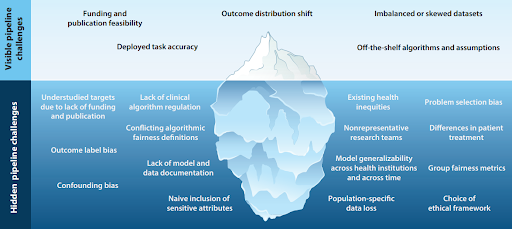The healthcare industry constantly seeks innovative ways to enhance patient care, improve treatment outcomes, and streamline medical processes. Machine learning and AI have found valuable applications in the industry, enabling the collection and management of patient data, identifying healthcare trends, providing treatment recommendations, making medical devices to help physicians, simplifying drug development, and medical imaging analysis.
The COVID-19 pandemic has only further accelerated the adoption of ML in healthcare. As the world grappled with the pandemic, machine learning was used to develop new diagnostic tools, track the spread of the virus, and design more effective treatments. Now, ML-driven methods aid in identifying initial signs of an epidemic or pandemic. This algorithm analyzes satellite data, news articles, social media updates, and even video content to assess the likelihood of the disease escalating beyond manageable levels.

Let's delve into several categories of AI and ML applications in the realm of healthtech and medicine:
- Diagnosis and disease prediction. AI and ML can analyze medical images, patient data, and symptoms to aid in accurate diagnosis and predict the onset of diseases.
ARIMA (AutoRegressive Integrated Moving Average) and Box-Cox transformation methods enable healthcare professionals to analyze historical data, identify patterns, and make accurate patient outcomes. - Medical imaging analysis. ML algorithms can analyze radiological images, such as X-rays and MRIs, to assist radiologists in detecting abnormalities and providing more accurate interpretations.
Machine learning can reduce over-testing, find minor defects, improve blood cancer treatment, and enhance clinical studies. - Visualization. ML can be harnessed to generate three-dimensional visualizations of various biomedical data, including RNA sequences, protein structures, and genomic profiles. This enables researchers and healthcare professionals to understand complex biological information better, facilitating insights and discoveries in biomedicine.
Researchers use decision forests, including random forests, for segmentation and prediction tasks in medical imaging. Deep learning models such as computer vision efficiently process vast amounts of medical image data. - Virtual assistants and chatbots. Conversational AI in healthcare can provide preliminary medical advice, answer patient queries, and assist in triage.
In their turn, artificial neural networks (ANNs) can generate computer-generated outcomes that closely resemble the diagnostic reasoning that a human would employ. - Precision medicine. Personalized treatment plans can be developed based on an individual's genetic makeup, medical history, and lifestyle data, leading to more targeted and effective therapies.
- Drug discovery and development. ML can speed up the identification and design of new drugs, optimize clinical trials, and improve drug safety assessment.
Machine learning algorithms analyze vast datasets, enabling the identification of potential pathways for new medications and innovative treatments. This reduces the time required for bringing new drugs to market and holds promise for addressing unmet medical needs. This ability is actively used by Atomwise. - Remote monitoring. AI-powered systems enable remote consultations, continuous patient monitoring, and remote diagnostics, enhancing access to healthcare services.
- Wearable devices and health tracking. ML algorithms can process data from wearable devices like fitness trackers and smartwatches to track vital signs, track physical activity, and provide real-time health insights.
- Electronic health records (EHR). Many EHR systems are limited in their accuracy. They rely on multiple collections of if-then rules. As the number of rules increases, conflicts arise, leading to inaccuracies. More data-based approaches and machine-learning algorithms are replacing these systems. These algorithms can extract meaningful insights from large volumes of EHR data, enabling improved patient care coordination, risk prediction, and population health management.
- Clinical decision support systems. AI-powered systems can provide evidence-based recommendations to healthcare professionals, assisting in diagnosis, treatment planning, and medication management. A natural language processing (NLP) application can also extract patient data from doctors' notes.
- Robotics assistance. AI-enabled robots can assist surgeons in performing complex procedures with precision, reducing invasiveness and enhancing patient safety. Robotic surgery can achieve many functions with reduced invasiveness, leading to fewer complications and improved patient outcomes.
Another significant application is robotic process automation (RPA), which emulates human actions for manual tasks like data entry. It enables physicians and medical administrators to allocate their time and efforts to more valuable activities. - Patient engagement and behavior modification. AI applications can provide personalized health coaching, reminders, and feedback to encourage lifestyle modifications.
- Healthcare staffing. AI and ML in healthcare staffing optimize the matching process, ensuring precision matches between professionals and positions. This technology reduces time and costs through automated recruitment processes. Continuous learning improves recommendations, while personalized suggestions cater to individual preferences. Real-time insights anticipate staffing shortages and bias mitigation, promoting equal opportunities.
Binary Studio has also contributed to developing ML solutions in healthcare stuffing. One such product, driven by advanced matching and verification algorithms, is SnapNurse. This platform seamlessly matches facilities with the highest quality, fully credentialed healthcare professionals whenever and wherever needed.
It is a flexible healthcare solution designed to address the dynamic nature of staffing needs. With the ability to deliver staff within 24–48 hours, SnapNurse ensures facilities have the right professionals at the right time, reducing the risks of under or over-staffing commonly associated with traditional approaches. This ensures seamless care provision and upholds high-quality standards. SnapNurse handles the complex logistics of healthcare staffing, considering factors such as location, specific requirements, and desired duration.
Hospitals and healthcare organizations increasingly acknowledge the potential of machine learning to enhance decision-making, cost-effective healthcare solutions, and mitigate risks in medicine. It would be advantageous to examine additional potential benefits more closely.
The Benefits of Machine Learning in Healthcare Product Development
There are various benefits to incorporating machine learning models in healthcare product development, which can be summarized as follows:
- Economic effectiveness. Machine learning drives cost efficiency by streamlining processes and optimizing resource allocation through intelligent data analysis and predictive modeling.
- Personalized treatment options. AI algorithms can generate tailored treatment recommendations by analyzing multi-modal data, including patient demographics, medical history, and genetic information. This individualized approach enhances patient care outcomes and fosters more precise and targeted interventions.
ML can accurately collect a patient's history and assist healthcare practitioners in asking relevant questions based on various factors. - Improved healthcare services experience. ML-assisted platforms aim to enhance the overall healthcare service for a bigger group of people, combining empathy with profit-generating purposes.
Additionally, machine learning algorithms can provide daily recommendations to physicians for reducing readmission rates and improving care delivery. - Automatization and robotic procedures. ML tools enhance surgical procedures by providing information during robotic surgeries and image-guided therapies. It enables the analysis of large volumes of medical data for connecting patient databases and aiding robotic systems.
The ML-based approach also streamlines healthcare informatics and improves data integrity, helps provide a family history for accurate decisions, handles online appointment scheduling, etc. - Disease detection and early intervention. Machine learning aids in the early detection of diseases, including diabetes, liver illness, and various disorders, enabling timely interventions.
- Detecting fraud. ML models enable the healthcare industry to identify and prevent invalid insurance claims, ensuring faster approval and payment for valid ones. These models not only detect fraud but also safeguard patient data. Organizations like Harvard Pilgrim Health are leveraging these technologies employing ML-based systems to identify suspicious claims and behaviors.
Additionally, ML contributes to advances in augmented reality, the Internet of Things, and white box testing in healthcare. As technology advances, the potential for AI-driven innovations is vast, promising improved patient care and advancements in medical research.
The Challenges and How to Overcome Them
There are some specificities in the development of machine learning products. ML distinguishes itself from traditional programming paradigms by relying on training rather than explicit programming. While conventional programming combines rules and data, ML systems are trained to learn from data and make predictions or decisions based on that learning.
It is essential to get high-quality data that describes the population that the ML model is meant to represent. However, current medical practice and knowledge have limitations, including biases and errors. Thus, understanding the pros and cons of AI in healthcare becomes essential as insights into human health need to be checked.

Source: TEDxUofTSalon by Marzyeh Ghassemi
Clinical data from hospitals and clinics, as well as knowledge from sources like randomized controlled trials and medical literature, are used to train machine learning models. The medical sector holds a wealth of information in health records, clinical trials, claims processing, billing records, etc. This data can be a valuable resource. That’s why effective data management strategies at all levels are essential for integrating machine learning models into healthcare systems. This includes developing data processing pipelines and user-friendly interfaces for ML products, which can convert raw data into datasets suitable for training models.
Collaboration with medical experts is crucial to ensure the accuracy of machine learning models. Medical professionals provide domain knowledge and contribute to acquiring ground truth data, which is essential for training and validating the models effectively. A key aspect of integrating doctors and algorithms is the feedback loop concept. By working in tandem with AI systems, doctors can refine and fine-tune algorithms, making them more effective in clinical settings.
Another significant challenge is that legal protocols may need more preparation to effectively address potential errors when utilizing predictive models for outcomes in healthcare scenarios. Additionally, obtaining, exchanging, and disseminating patient data poses significant challenges due to stringent privacy and security restrictions. The availability of data has witnessed a rapid surge in recent years. With further advancements, ML will integrate with data and analytics, reshaping data storage, sharing, and use across various healthcare applications. Yet, hospitals must possess good, reliable, and timely data management systems.
 Source: Annual Review of Biomedical Data Science
Source: Annual Review of Biomedical Data Science
To overcome possible challenges in using AI and ML in healthcare product development, companies can employ the following strategies:
- Data availability and quality. Investing in data cleaning and preprocessing techniques. Before applying a machine learning tool, you must gather, clean, validate, and structure the data for its intended purposes. Collaborating with healthcare providers to collect and share data, breaking down data silos, and using federated learning approaches to train models are essential for ensuring the accuracy and reliability of data sets in healthtech.
- Regulatory compliance. Ensuring ML products comply with relevant regulations in the healthcare industry. This involves understanding and adhering to legal and ethical frameworks to guarantee the safety of AI-powered healthcare solutions.
- Ethical considerations. Employing transparent and accountable models. Safeguarding patient privacy and ensuring data protection.
- Technical expertise. Developing and deploying AI and ML products requires specialized technical skills. Companies may need to collaborate with AI experts or hire professionals with expertise in these technologies to navigate the implementation complexities.
ML applications in healthcare hold tremendous promise as ongoing research and innovation continuously unveil new possibilities across various domains. Although these compiled disadvantages and solutions are not exhaustive, they shed light on the main challenges in this burgeoning field.
Real-World Examples of AI and ML in Healthtech
ML has found numerous real-life applications in healthtech, revolutionizing healthcare delivery and benefiting patients in various ways. When exploring these examples, it is essential to note that while new machine learning applications continue to emerge, the primary focus remains on enhancing the quality of care and improving patient health outcomes. Machine learning aims to enhance patient outcomes and uncover previously inaccessible medical insights, driving improvements in healthcare.
Enlitic
Enlitic uses AI to analyze medical images, including mammograms, to detect breast cancer earlier and more accurately, with a 94.5% accuracy rate. They also forecast a wide range of scenarios to predict breast cancer and create optimal treatments for women diagnosed.

Source: Breast Cancer Wisconsin (Diagnostic)
Migraine Buddy
The Migraine Buddy app uses ML to predict headaches and recommend ways to prevent them. It allows users to log various factors such as the severity and duration of their migraines, potential triggers, and any medication or remedies used for relief.
By employing ML algorithms, Migraine Buddy can provide personalized treatment recommendations and shift the healthcare focus from reactive to preventive care for individuals suffering from migraines. This application assists clinicians in delivering tailored therapies that align precisely with each patient's unique characteristics and migraine symptoms, ultimately empowering users to manage their condition more effectively and improve their quality of life.
BetaBionics
BetaBionics' iLet, a portable "bionic" pancreas, employs ML models and wearable technology to improve diabetes management. Early indicators are identified, promoting lifestyle changes, while automated glucose monitoring reduces patients' daily tracking burden. This advancement leads to better outcomes and a stress-free experience for individuals with diabetes.
Path AI
Path AI is a technology provider focusing on precision pathology solutions with a strong emphasis on AI. Their approach involves utilizing a vast amount of data, including over 15 million annotations sourced from their proprietary pathology network, which comprises more than 450 pathologists. Additionally, they have built a comprehensive library of archived data.
These advanced tools have the potential to accelerate drug development, enhance diagnostic accuracy, and expedite the delivery of life-saving therapies to patients.
Microsoft
InnerEye, a research project by Microsoft Health Futures, leverages advanced machine learning technology to develop tools for automated and quantitative analysis of three-dimensional medical images. The project aims to make AI accessible for medical image analysis, enabling machine learning for medical imaging using Microsoft Azure.
With the help of algorithms, CT scans can automatically identify and outline specific organs, like the kidneys.

Source: Microsoft Research: Machine Learning in Health Care
This automated approach significantly reduces the time-consuming and error-prone process of manual organ identification and delineation within these scans. InnerEye's advanced technology exemplifies how AI can revolutionize medical image analysis, streamlining the identification of organs and improving the accuracy of diagnoses.
Machine learning algorithms play a pivotal role in brain tumor segmentation, facilitating the identification of distinct tumor regions. This breakthrough empowers medical professionals to target specific areas for personalized therapies, ultimately leading to enhanced treatment outcomes.

Source: Microsoft Research: Machine Learning in Health Care
The application of such advanced technology, like InnerEye's research project by Microsoft, underscores the potential of AI in revolutionizing medical image analysis and optimizing patient care in neuro-oncology.
The Potential of ML to Revolutionize Healthcare
Machine learning in healthcare is growing, driven by the changing needs of patients and the increasing availability of data. Changing lifestyles increased life expectancy, and rising prevalence of diseases have all contributed to the demand for better and more accurate healthcare solutions. In response, healthcare providers increasingly turn to machine learning to improve the quality of care and medical research, reduce costs, and make healthcare more accessible.
With rapid technological advancements, the Internet of Medical Things (IoMT) has emerged as a network connecting various medical devices and applications, enabling seamless communication through online networks. A growing number of such medical devices opens up many possibilities, such as remote patient monitoring, tracking medical histories, aggregating data from wearable devices, and much more. As the market witnesses a surge in wearable and internet-enabled medical devices, experts predict that the IoMT will experience exponential growth.

Source: Fortune Business Insights: The global internet of medical things (IoMT) market
Leveraging AI to develop intelligent processes and workflows has the potential to enhance healthcare affordability, effectiveness, personalization, and equity. These opportunities can offer new career paths in the healthcare industry and lead to innovative ideas.
The intersection of AI and ML with healthcare product development transforms how medical devices, pharmaceuticals, and digital health solutions are conceptualized, designed, and brought to market. ML's impact extends to consumer health applications, enhancing patients' experiences outside of hospitals and enabling the identification of high-risk individuals in a population.
Recently, crowdsourcing has emerged as a valuable tool in improving data, allowing researchers and practitioners to access a wealth of data contributed by individuals with their consent. This real-time health data has significant implications for the future of medicine. By analyzing vast amounts of information from sources like social media, satellites, websites, and institutional records, this technology can aid in predicting and addressing various health issues, including malaria outbreaks and infectious diseases. While updating and managing health data can be time-consuming and expensive, crowdsourcing has helped streamline the data entry process. However, many tasks still require manual completion, resulting in delays.
Machine learning will undoubtedly expand its footprint in healthcare in the coming years. AI is expected to play an important role in precision medicine, imaging analysis, speech, and text recognition, but human clinicians will be augmented rather than replaced by AI systems. Therefore, healthcare workers and clinicians should use machine learning to their advantage.
Final Thoughts
ML is currently exerting a remarkable influence on various aspects of our world. Researchers are harnessing algorithms for early cancer detection by identifying specific biomarkers in blood samples, for lab diagnosis, image, and cycle management, intelligent clinical data analysis, and computer-aided medical procedures like organ recognition and tissue characterization.
Machine learning is revolutionizing the healthcare industry, driving massive improvements and innovations. From clinical operations to drug development, from surgery to data management (estimating emergency department volumes and improved staffing).
Contact our experts if you are also looking for ML software development services. We are committed to providing our clients with the most tech-friendly solutions possible and deeply understand how machine learning is used in healthcare, implementing it in our products.





